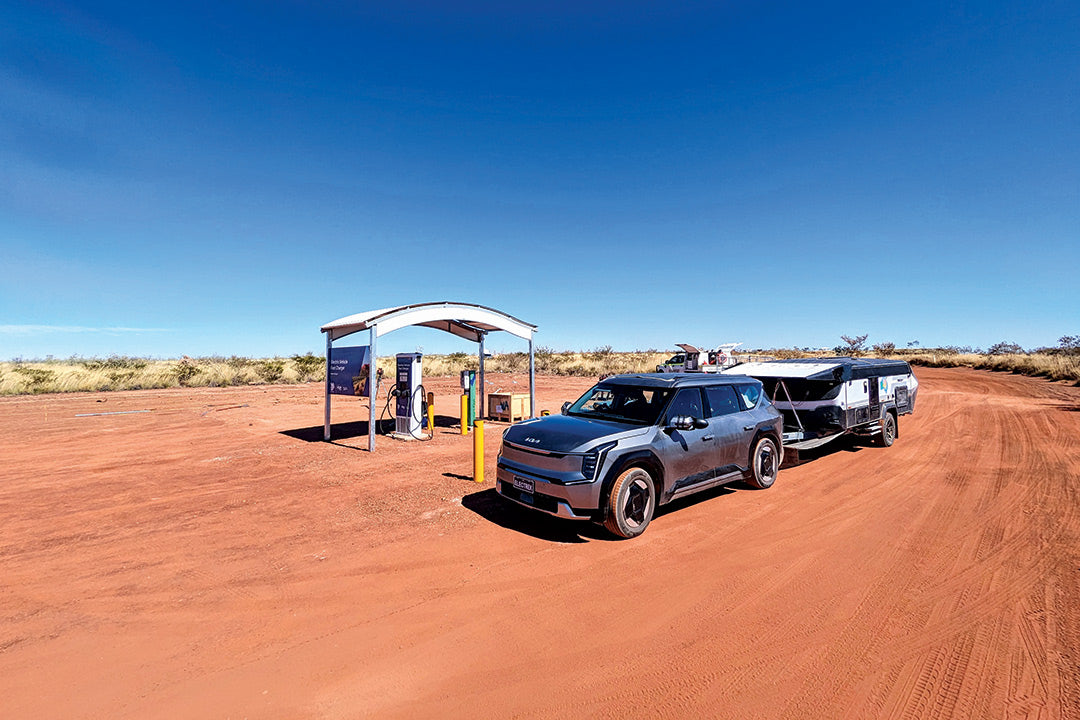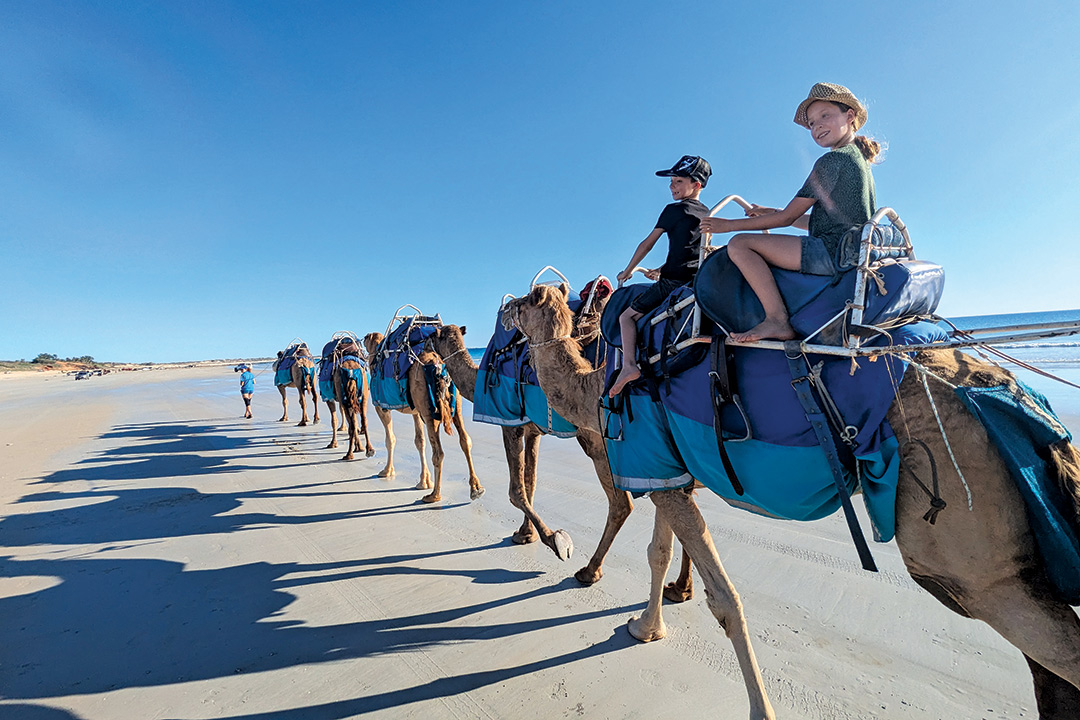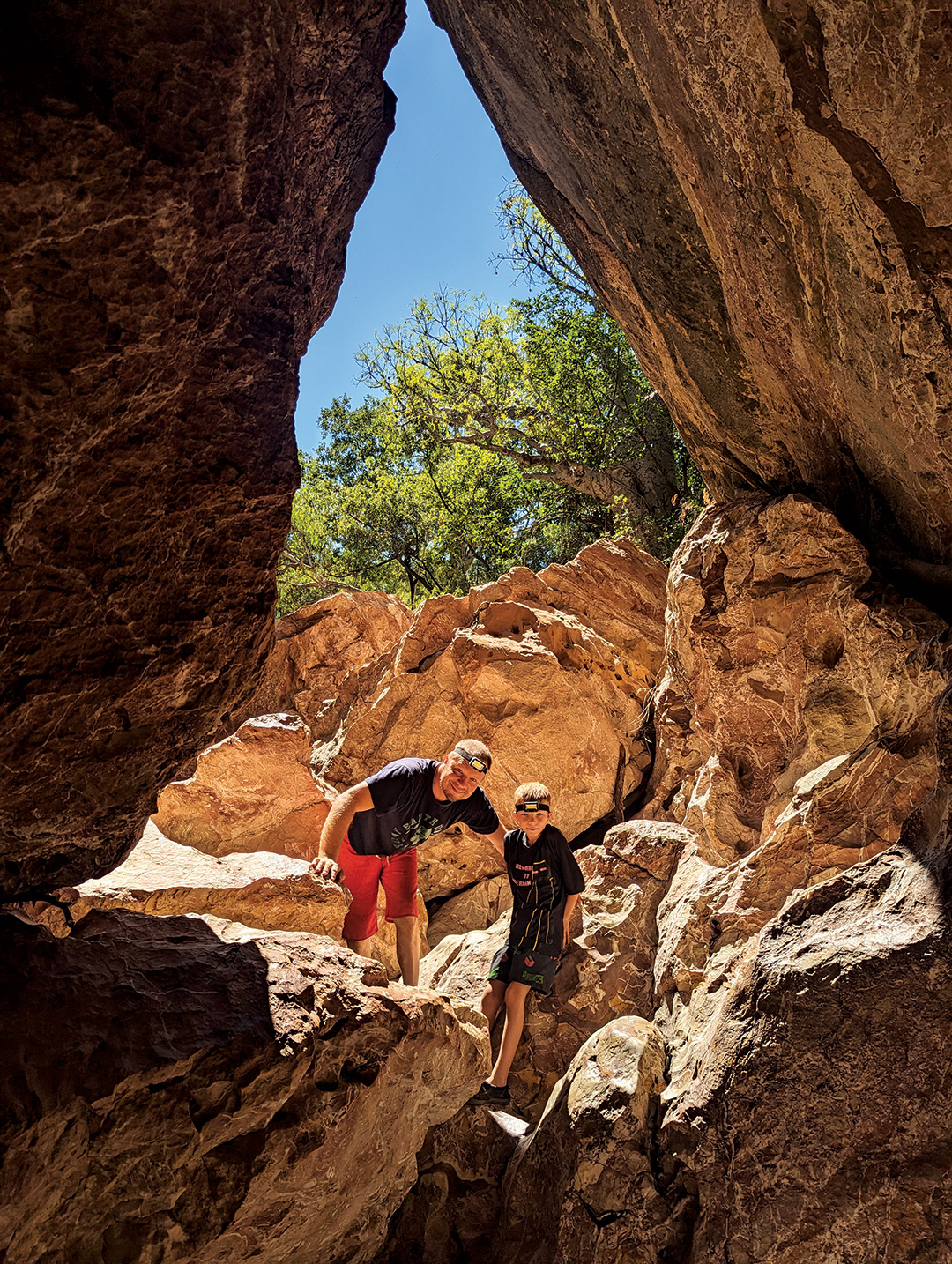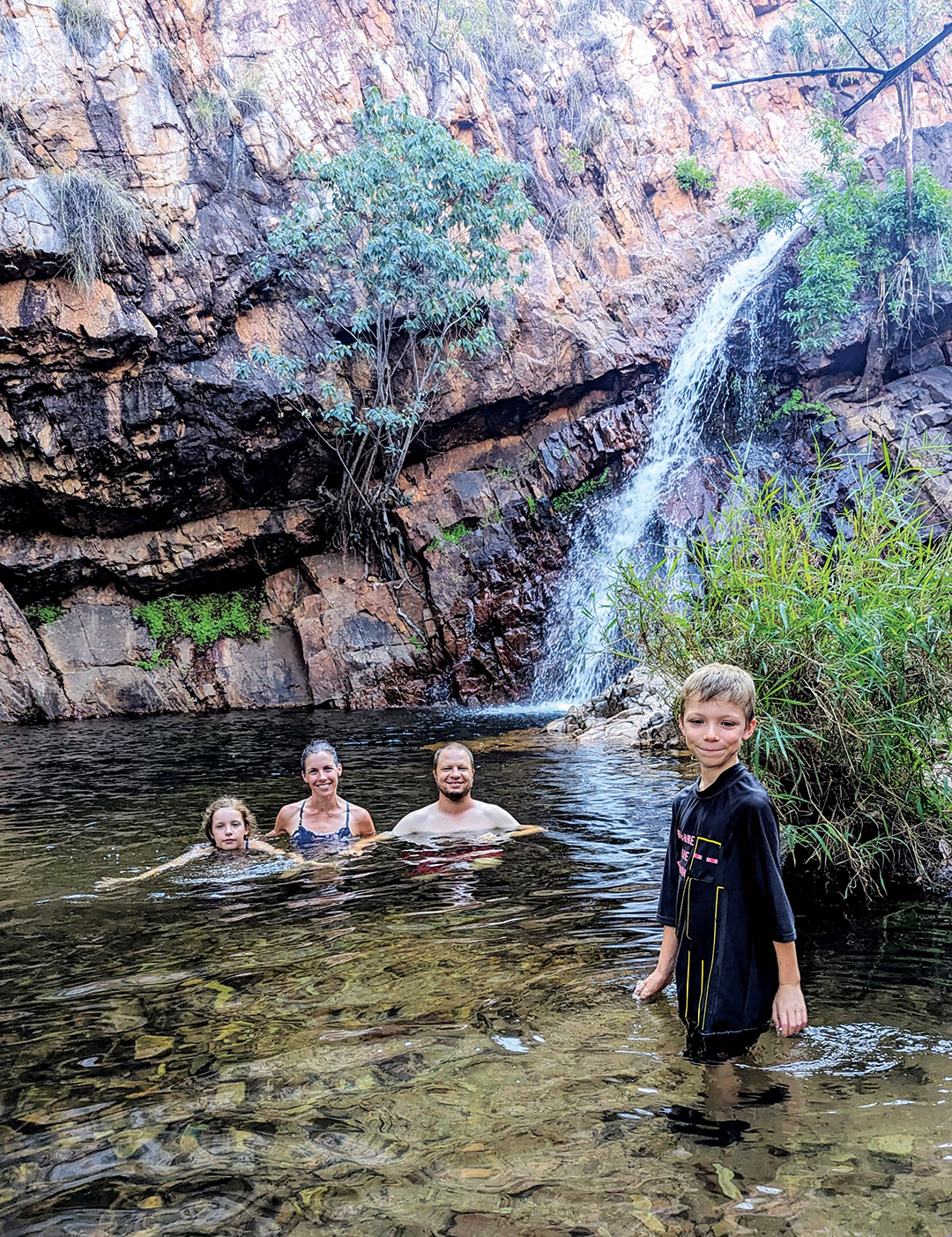

Mueller Ranges charger under construction
The McLennan family and their all-electric setup (a Kia EV and New Age camper) have reached the rugged Kimberley ready to tackle the iconic Gibb River Road heading east from Broome to Kununurra.
The rugged Kimberley region in northern Western Australia with its isolation, stunning natural beauty and rich cultural heritage is likely to be a highlight of any Big Lap trip. Broome provided the springboard for our own Kimberly adventure, searching for dinosaur footprints in the sandstone, riding camels along the beach, learning about the town’s fascinating history, witnessing the impressive tides and getting up close with the terrifying saltwater crocs.
 Ellie and Xavier riding camels on Cable Beach, Broome
Ellie and Xavier riding camels on Cable Beach, Broome
From Broome we headed to Derby, the gateway to the legendary Gibb River Road. The Gibb is a true wilderness adventure and one that we wanted to try and tackle if possible. By now we were confident we knew the extent of the Kia EV9’s offroad capabilities, especially when driving long distances. In our planning we had also received positive responses from various stations along the former cattle route to our requests to charge from their power source. Combined with top ups from our solar panels, we were feeling pretty certain that charging options or offroad capability of the vehicle wouldn’t be the limiting factor, but that the water levels would be the main challenge.
In the end, the decision about whether to tackle the Gibb was taken out of our hands as the route still remained closed following the wet season. It will have to be an adventure for another day and gives us an excuse to come back to this part of the country again. By then, there will undoubtedly be multiple options for fully offroad EVs available in Australia, such as Rivian, F-150 Lightning and the BYD dual cab.
For more information on EVs in Australia, check out this feature.
Instead of accessing Dimalurru (Tunnel Creek) National Park from the Gibb as originally planned, we instead went in from the south, allowing us to still visit Tunnel Creek and Bandilngan (Windjana Gorge). We first needed to stop in at Fitzroy Crossing for a charge before heading back to our free campsite at the RAAF Boab Quarry. There had been a strong head wind, and our charge was getting pretty low and our calculations indicated we might not make it into town. To extend our range, we dropped the camper at the junction heading into the Quarry and continued on the final 20km into Fitzroy Crossing without it, instantly almost doubling our remaining range. The town’s newly installed 150kW fast EV charger was quick and easy and only just provided time to do a grocery shop before backtracking to pick up the camper and continue on into the Quarry campsite. A bonus was that the charger’s payment system was yet to be commissioned and therefore free to use!
 Tim and Xavier at Tunnel Creek
Tim and Xavier at Tunnel Creek
Tunnel Creek was a unique adventure, scrambling over rocks to enter the cave and wading along the creek that runs underground through the pitch black caverns inhabited by freshwater crocodiles, one of which swam so close to Tim in the deepest, darkest swimming section that it brushed against his leg in the water. The only other indicator of its presence was two glowing eyes gliding silently past. Once again, we had the place to ourselves for much of the time, which just added to the eeriness of being in the cave. Another experience to add to the highlights list.
On the way to Halls Creek, we camped at the delightful Mimbi Caves. The campsites are all unpowered, but the manager was very accommodating, allowing us to run an extension cord from their office to our EVSE (electric vehicle supply equipment) and use their excess solar to top up our battery, taking any stress out of bridging the gap between Fitzroy Crossing and Halls Creek. It won’t be long before this stretch is also easily accessible for electric travel with construction of the Mueller Ranges WA EV Network fast charger and solar array well underway just a few kilometres down the road.
We had hoped to make it into Purnululu National Park (The Bungle Bungles), but the entry to the national park has several water crossings, some of which remained high following the last big wet season. Despite multiple enquiries seeking confirmation of the EV9’s wading depth it was still to be clarified by Kia, so we reluctantly decided not to risk it. Disappointing, but we didn’t want to damage the car and sabotage the rest of our trip. Compared to an ICE (internal combustion engine) vehicle, EVs have great potential for being able to traverse water as the electric motor doesn’t require oxygen and if the connectors and components are waterproofed it is much less likely to fail when submerged. This was demonstrated dramatically in 2023 when a converted LandCruiser was driven 7km underwater to cross Darwin Harbour. It will be interesting to know the details of the waterproofing efforts Kia has gone to with the EV9.
However, we didn’t let that stop us from getting through the small water crossing to access El Questro Wilderness Park’s magnificent Emma Gorge. The trek up to the waterfall was a bit of a tricky one for Tim and his splints, but well worth the effort.
 Ellie enjoying the view, Emma Gorge in El Questro
Ellie enjoying the view, Emma Gorge in El Questro
After exploring the many attractions around Kununurra, we spent a few peaceful days at Lake Argyle, the inland sea created by the Ord River Dam and one of the world’s largest man-made lakes. We were fortunate to score a secluded spot in the unpowered section of the campgrounds with beautiful views of the landscape surrounding the lake. The dam’s hydroelectric plant provides enough green energy to power the surrounding communities saving over 60 million litres of diesel per year. The sunset cruise including a swim (with the lake’s 25,000 freshwater crocodile inhabitants) was a definite highlight.
 McLennan family at Molly Springs, Kununurra
McLennan family at Molly Springs, Kununurra
From there it was time to say goodbye to Western Australia and venture over the border into the Northern Territory. We are now looking forward to seeing what adventures and challenges the Territory has in store for us.
Trip Summary Perth to WA/NT Border
- Distance travelled: 8140km
- Amount spent at chargers: $466 * Variety of fast chargers ($0.60/kWh) and slow chargers ($0.35/kWh) including some free charging stations
- Towing range per charge: 260–300km varying depending on speed, road surface, wind, changes in elevation
- Average overall energy consumption: 3.1km/kWh or 32.2kWh/100km (includes both towing plus shorter day trips without the camper)
- Average energy consumption towing: 2.8km/kWh or 35.7kWh/100km
- Lowest efficiency: Cheela Plains to Tom Price 2.1km/kWh ascending and into head wind (47.6kWh/100km)
- Best efficiency: Auski Roadhouse to Port Hedland 3.4km/kWh (29.4 kWh/100km)
* Plus the cost of powered campsites where we topped up the car battery along the way.
Plug in to our electric adventure on social media:
Website | Facebook | Instagram
The adventure will continue next month as the McLennan family continues exploring some of Australia's best rural and remote areas during their all-electric Big Lap.
To find out more about what this Perth couple and their kids have been up to, check out the previous features below.
THE NEXT STEP
If you want to learn the latest caravan news, find the most innovative new caravans and camping gear or get inspired to plan your next towing adventure in the great outdoors, subscribe to our weekly newsletter. We promise to send you only the best content.
Related Articles:
1. Heading off on an EV Big Lap | A family road trip adventure







